Plot summary
Lynette and her sister Leonie have a dual wedding to the brothers Gaheris and Gareth, respectively. After the festivities are over, the two sisters are dragged to their bedrooms and prepared by bridesmaids for the first night of their honeymoons. Lynette is miserable, as she is in fact in love with Gareth, and thinks with envy of Leonie. She is also terrified of what is about to happen, as she was raped by a friend of her father's who was like a mentor to her. She is convinced that Gaheris will know that she is not a virgin, and she will be publicly shamed. However, when Gaheris enters the honeymoon suite, he merely comments that he does not want this, either. He sleeps next to her, without touching, and leaves before she wakes.
In a flashback to the events leading up to the wedding, the Red Knight, a knight who claims to owe no loyalty to King Arthur, attacks Lynette's home in the absence of any male figureheads, holding the household hostage until Leonie consents to marry him and make him Lord. Lynette disguises herself as a servant boy and escapes, going to Camelot and pleading with Arthur to help her rescue Leonie. Aided by Merlin (who had appeared to her once before, after she was raped), she receives Arthur's blessing, but he only sends one man with her – Gareth, whom she presumes to be a kitchen boy. She is rude to him, feeling resentful towards Arthur for his choice. However, Gareth soon proves himself and in the course of rescuing Leonie, Lynette realises that she has fallen in love with him. Upon the group's return to Camelot, it is arranged that Gareth shall marry Leonie as his reward, and Lynette shall wed Gareth's older brother, Gaheris.
After Gaheris' departure, Lynette is worried about what will happen to her – abandoned by her husband, and forced to watch Gareth in Leonie's company. Again Merlin intervenes, and Lynette convinces Arthur to make her his messenger. She is to go alone ahead of the knights to persuade unruly Lords to swear their allegiance to Arthur.
Lynette acts so bravely and gracefully in the course of this work that she earns the respect of all those who travel with her (including Guinevere's unlucky admirer, Lancelot). She later meets up again with the man who raped her as a child and beheads him; she is later haunted by his ghost, but eventually forgives him, freeing herself from the creatures which were released each time she laid a curse upon him.
She is also separated from her party in strange lands and kidnapped; she eventually finds her way out through a network of caves with the help of a young man named Lucius. Lucius has lived in the dark so long that he is blind and pale. Lucius was imprisoned along with his mother, who subsequently died, but he met a sort of witch outside the caves who befriended him, and he is happy with his simple life. Lynette spends time with the pair, and eventually falls in love with Lucius. Lynette feels simultaneously pleased that Lucius can not see how plain she is, and guilty for being convinced that he would not want her if he could only see her.
Eventually, the witch informs Lynette that Lucius is dying. Horrified, Lynette decides to seek out the Holy Grail and use it to save Lucius. She sets out with her travelling companions from before, and after a long journey, she manages to retrieve the Grail. She hurries back with it to Lucius, resolving that she will let him do with it as he pleases. Upon receiving the Grail, Lucius wishes for sight rather than life, so that he can finally see Lynette. Upon opening his eyes, he cries out with delight, repeatedly telling Lynette that she is beautiful.
The pair have a little more time together, which Lynette tries to make the best of. Lucius dies, and she and the witch bury him before she sets out once again, to resume her post as the King's Damosel.

Guinevere, also often written in Modern English as Guenevere or Guenever, was, according to Arthurian legend, an early-medieval queen of Great Britain and the wife of King Arthur. First mentioned in popular literature in the early 12th century, nearly 700 years after the purported times of Arthur, Guinevere has since been portrayed as everything from a fatally flawed, villainous and opportunistic traitor to a noble and virtuous lady. Many records of the legend also feature the variably recounted story of her abduction and rescue as a major part of the tale.

Gawain, also known in many other forms and spellings, is a character in Arthurian legend, in which he is King Arthur's nephew and one of the premier Knights of the Round Table. The prototype of Gawain is mentioned under the name Gwalchmei in the earliest Welsh sources. He has subsequently appeared in many Arthurian tales in Welsh, Latin, French, English, Scottish, Dutch, German, Spanish, and Italian, notably as the protagonist of the Middle English poem Sir Gawain and the Green Knight. Other works featuring Gawain as their central character include De Ortu Waluuanii, Diu Crône, Ywain and Gawain, Golagros and Gawane, Sir Gawain and the Carle of Carlisle, L'âtre périlleux, La Mule sans frein, La Vengeance Raguidel, Le Chevalier à l'épée, Le Livre d'Artus, The Awntyrs off Arthure, The Greene Knight, and The Weddynge of Syr Gawen and Dame Ragnell.

Idylls of the King, published between 1859 and 1885, is a cycle of twelve narrative poems by the English poet Alfred, Lord Tennyson which retells the legend of King Arthur, his knights, his love for Guinevere and her tragic betrayal of him, and the rise and fall of Arthur's kingdom.

Lancelot du Lac, also written as Launcelot and other variants, is a character in some versions of Arthurian legend where he is typically depicted as King Arthur's close companion and one of the greatest Knights of the Round Table. In the French-inspired Arthurian chivalric romance tradition, Lancelot is an orphaned son of King Ban of the lost kingdom of Benoic, raised in a fairy realm by the Lady of the Lake. A hero of many battles, quests and tournaments, and famed as a nearly unrivalled swordsman and jouster, Lancelot becomes the lord of the castle Joyous Gard and personal champion of Arthur's wife, Queen Guinevere, despite suffering from frequent and sometimes prolonged fits of madness. But when his adulterous affair with Guinevere is discovered, it causes a civil war that, once exploited by Mordred, brings an end to Arthur's kingdom.

The Lady of the Lake is a name or a title used by several either fairy or fairy-like but human enchantresses in the Matter of Britain, the body of medieval literature and mythology associated with the legend of King Arthur. She plays several important roles in many stories, including providing Arthur with the sword Excalibur, eliminating Merlin, raising Lancelot after the death of his father, and helping to take the dying Arthur to Avalon. Different sorceresses known as the Lady of the Lake appear concurrently as separate characters in some versions of the legend since at least the Post-Vulgate Cycle and consequently the seminal Le Morte d'Arthur, with the latter describing them as a hierarchical group, while some texts also give this title to either Morgan or her sister.
Morgause is a popular variant of the figure of the Queen of Orkney, an Arthurian legend character also known by various other names and appearing in different forms of her archetype. She is notably the mother of Gawain and often also of Mordred, both key players in the story of her brother King Arthur and his downfall. Her other children may include Agravain, Gareth and Gaheris.

Percival, alternatively called Peredur, is a figure in the legend of King Arthur, often appearing as one of the Knights of the Round Table. First mentioned by the French author Chrétien de Troyes in the tale Perceval, the Story of the Grail, he is best known for being the original hero in the quest for the Grail, before being replaced in later literature by Galahad.
Percival's sister is a role of two similar but distinct characters in the Holy Grail stories within the Arthurian legend featuring the Grail hero Percival (Perceval). The first of them is named Dindrane, the second is usually unnamed and is known today as the Grail heroine.
Red Knight is a title borne by several characters in Arthurian legend.
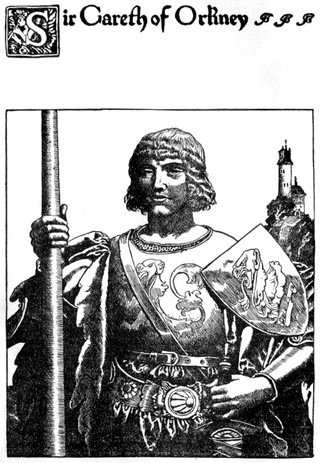
Gareth is a Knight of the Round Table in Arthurian legend. He is the youngest son of King Lot and Queen Morgause, King Arthur's half-sister, thus making him Arthur's nephew, as well as brother to Gawain, Agravain and Gaheris, and either a brother or half-brother of Mordred. Gareth is particularly notable in Le Morte d'Arthur, where one of its eight books is named after and largely dedicated to him, and in which he is also known by his nickname Beaumains.

King Lot, also spelled Loth or Lott, is a British monarch in Arthurian legend. He was introduced in Geoffrey of Monmouth's pseudohistorical Historia Regum Britanniae as King Arthur's brother-in-law, who serves as regent of Britain between the reigns of Uther Pendragon and Arthur. He has appeared regularly in works of chivalric romance, alternating between the roles of Arthur's enemy and ally, and is often depicted as the ruler of Lothian and either Norway or Orkney. His literary character is probably derived from hagiographical material concerning Saint Kentigern, which features Leudonus as king of Leudonia and father of Saint Teneu.
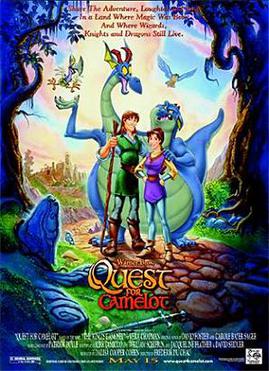
Quest for Camelot is a 1998 American animated musical fantasy film produced by Warner Bros. Feature Animation and directed by Frederik Du Chau and very loosely based on the 1976 novel The King's Damosel by Vera Chapman. It features the voices of Jessalyn Gilsig, Cary Elwes, Gary Oldman, Eric Idle, Don Rickles, Jaleel White, Jane Seymour, Bronson Pinchot, Pierce Brosnan, Gabriel Byrne, John Gielgud, Frank Welker, and Sarah Rayne. Andrea Corr, Bryan White, Celine Dion, and Steve Perry perform the singing voices for Gilsig, Elwes, Seymour, and Brosnan. The story follows Kayley (Gilsig), the adventurous daughter of a Knight of the Round Table killed by the power-hungry Lord Ruber (Oldman). When Ruber's renewed attempt to usurp Camelot from King Arthur (Brosnan) by stealing Excalibur goes awry, Kayley enlists the help of the blind recluse Garrett (Elwes) and a two-headed dragon, Devon and Cornwall, to help her retrieve the sword and save the kingdom.

Gaheris is a Knight of the Round Table in the chivalric romance tradition of Arthurian legend. A nephew of King Arthur, Gaheris is the third son of Arthur's sister or half-sister Morgause and her husband Lot, King of Orkney and Lothian. He is the younger brother of Gawain and Agravain, the older brother of Gareth, and half-brother of Mordred. His figure may have been originally derived from that of a brother of Gawain in the early Welsh tradition, and then later split into a separate character of another brother, today best known as Gareth. German poetry also described him as Gawain's cousin instead of brother.
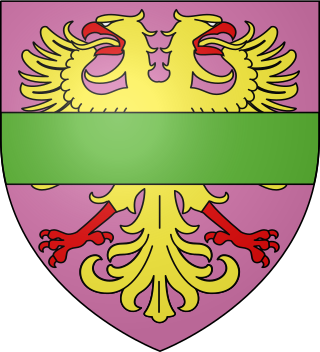
Agravain is a Knight of the Round Table in Arthurian legend, whose first known appearance is in the works of Chrétien de Troyes. He is the second eldest son of King Lot of Orkney with one of King Arthur's sisters known as Anna or Morgause, thus nephew of King Arthur, and brother to Sir Gawain, Gaheris, and Gareth, as well as half-brother to Mordred. Agravain secretly makes attempts on the life of his hated brother Gaheris starting in the Vulgate Cycle, participates in the slayings of Lamorak and Palamedes in the Post-Vulgate Cycle, and murders Dinadan in the Prose Tristan. In the French prose cycle tradition included in Thomas Malory's Le Morte d'Arthur, together with Mordred, he then plays a leading role by exposing his aunt Guinevere's affair with Lancelot, which leads to his death at Lancelot's hand.

Lionel is a character in Arthurian legend. He is the younger son of King Bors of Gaunnes and Evaine and brother of Bors the Younger. First recorded in the Lancelot-Grail cycle, he is a double cousin of Lancelot and cousin of Lancelot's younger half-brother Hector de Maris. He is also the subject of a traditional ballad.

In Arthurian legend, Ywain, also known as Yvain and Owain among other spellings, is a Knight of the Round Table. Tradition often portrays him as the son of King Urien of Gorre and of either the enchantress Modron or the sorceress Morgan le Fay. The historical Owain mab Urien, the basis of the literary character, ruled as the king of Rheged in Britain during the late-6th century.
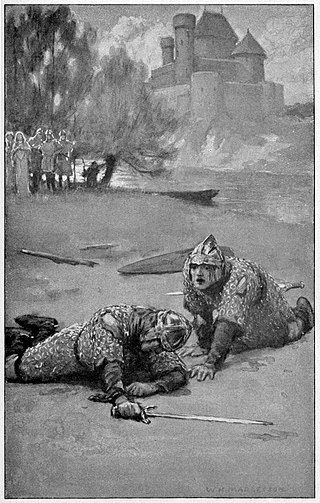
Balinthe Savage, also known as the Knight with the Two Swords, is a character in the Arthurian legend. Like Galahad, Balin is a late addition to the medieval Arthurian world. His story, as told by Thomas Malory in Le Morte d'Arthur, is based upon that told in the continuation of the second book of the Post-Vulgate cycle of legend, the Suite du Merlin.

In some versions of Arthurian legend, Lynette is a haughty noble lady who travels to King Arthur's court seeking help for her beautiful sister Lyonesse, whose lands are besieged by the Red Knight. The young Gareth picks up the quest, eventually marrying Lyonesse, while Lynette becomes the lady of his brother Gaheris.

The Candle in the Wind is a fantasy novel by English writer T. H. White, the fourth book in the series The Once and Future King. Written in 1940, it was first published in 1958 in the collected edition. It deals with the last weeks of Arthur's reign, his dealings with his son Mordred's revolts, Guinevere and Lancelot's demise, and his perception of right and wrong.
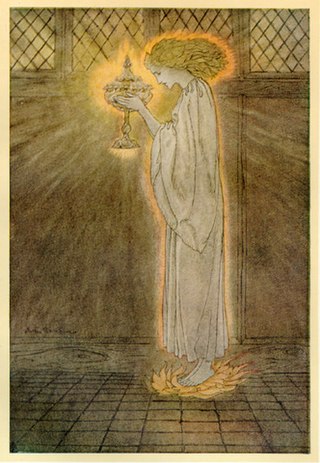
Elaine or Elizabeth, also known as Amite, and identified as the "Grail Maiden" or the "Grail Bearer", is a character from Arthurian legend. In the Arthurian chivalric romance tradition from the Vulgate Cycle, she is the daughter of the Fisher King, King Pelles of Corbenic, and the mother of Galahad by Lancelot, whose repeated rape by her results in his descent into madness. She should not be confused with Elaine of Astolat, a different woman who too fell in love with Lancelot.

















